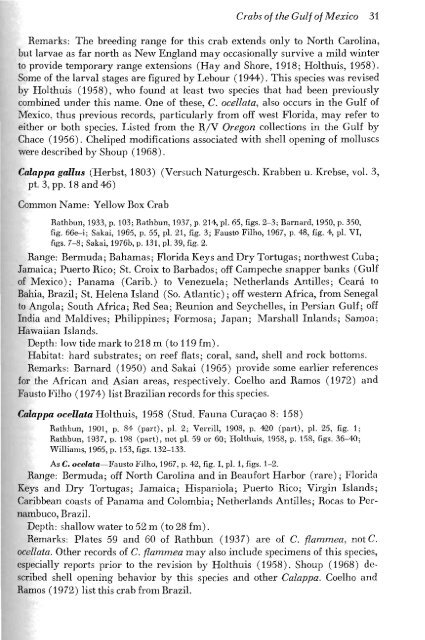Create successful ePaper yourself
Turn your PDF publications into a flip-book with our unique Google optimized e-Paper software.
Crabs of the Gulf of Mexico 31<br />
Remarks: The breeding range for this crab extends only to North Carolina,<br />
but larvae as far north as New England may occasionally survive a mild winter<br />
to provide temporary range extensions (Hay and Shore, 1918; Holthuis, 1958).<br />
Some of the larval stages are figured by Lebour (1944). This species was revised<br />
by Holthuis (1958), who found at least two species that had been previously<br />
combined under this name. One of these, C. ocellata, also occurs in the Gulf of<br />
Mexico, thus previous records, particularly from off west Florida, may refer to<br />
either or both species. Listed from the R/V Oregon collections in the Gulf bj^<br />
Chace (1956). Cheliped modifications associated with shell opening of molluscs<br />
were described bjr Shoup (1968).<br />
Calappa gallus (Herbst, 1803) (Versuch Naturgesch. Krabben u. Krebse, vol. 3,<br />
pt. 3, pp. 18 and 46)<br />
Common Name: Yellow Box Crab<br />
Rathbun, 1933, p. 103; Rathbun, 1937, p. 214, pi. 65, figs. 2-3: Barnard, 1950, p. 350,<br />
fig. 66e-i; Sakai, 1965, p. 55, pi. 21, fig. 3; Fausto Filho, 1967, p. 48, fig. 4, pi. VI,<br />
figs. 7-8; Sakai, 1976b, p. 131, pi. 39, fig. 2.<br />
Range: Bermuda; Bahamas; Florida Keys and Dry Tortugas; northwest Cuba;<br />
Jamaica; Puerto Rico; St. Croix to Barbados; off Campeche snapper banks (Gulf<br />
of Mexico); Panama (Carib.) to Venezuela; Netherlands Antilles; Ceara to<br />
Bahia, Brazil; St. Helena Island (So. Atlantic); off western Africa, from Senegal<br />
to Angola; South Africa; Red Sea; Reunion and Seychelles, in Persian Gulf; off<br />
India and Maldives; Philippinss; Formosa; Japan; Marshall Inlands; Samoa;<br />
Hawaiian Islands.<br />
Depth: low tide mark to 218 m (to 119 fm).<br />
Habitat: hard substrates; on reef flats; coral, sand, shell and rock bottoms.<br />
Remarks: Barnard (1950) and Sakai (1965) provide some earlier references<br />
lor the African and Asian areas, respectivelj^ Coelho and Ramos (1972) and<br />
Fausto Filho (1974) list Brazilian records for this species.<br />
Calappa ocellata Holthuis, 1958 (Stud. Fauna Curagao 8: 158)<br />
Rathbun, 1901, p. 84 (part), pi. 2; Verrill, 1908, p. 420 (part), pi. 25, fig. 1;<br />
Rathbun, 1937, p. 198 (part), not pi. 59 or 60; Holthuis, 1958, p. 158, figs. 36-40;<br />
Williams, 1965, p. 153, figs. 132-133.<br />
As C. oceJata—Fausto Filho, 1967, p. 42, fig. I, pi. 1, figs. 1-2.<br />
Range: Bermuda; off North Carolina and in Beaufort Harbor (rare); Florida<br />
Keys and Dry Tortugas; Jamaica; Hispaniola; Puerto Rico; Virgin Islands;<br />
Caribbean coasts of Panama and Colombia; Netherlands Antilles; Rocas to Pernambuco,<br />
Brazil.<br />
Depth: shallow water to 52 m (to 28 fm).<br />
Remarks: Plates 59 and 60 of Rathbun (1937) are of C. flammea, not C.<br />
ocellata. Other records of C. flammea may also include specimens of this species,<br />
especially reports prior to the revision bj^ Holthuis (1958). Shoup (1968) described<br />
shell opening behavior by this species and other Calappa. Coelho and<br />
Ramos (1972) list this crab from Brazil.

















